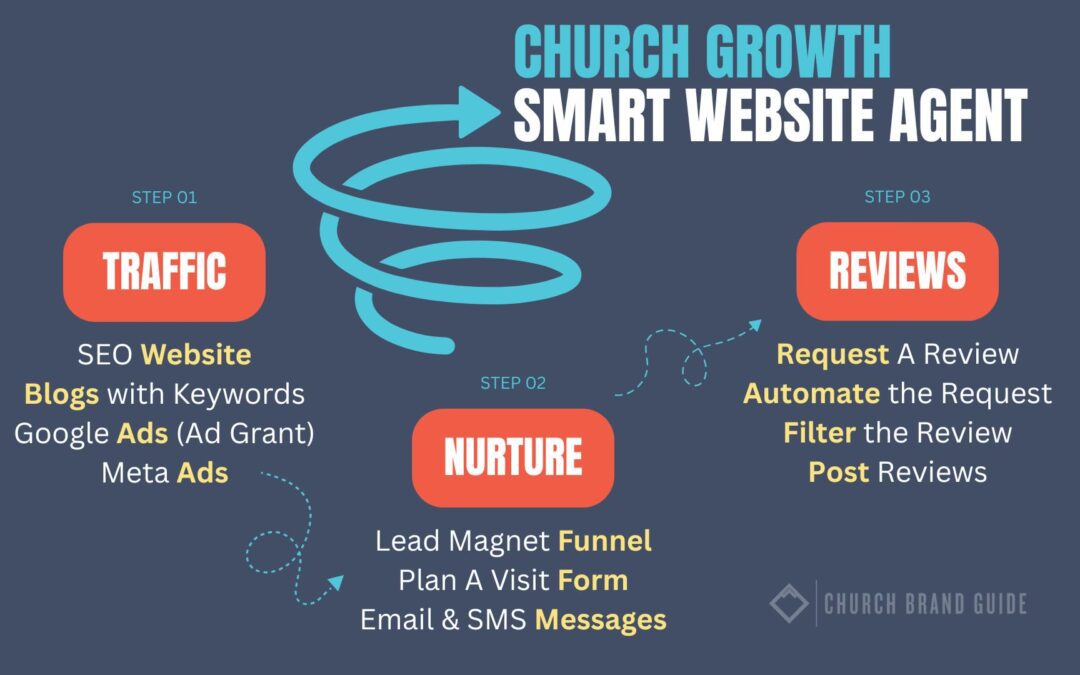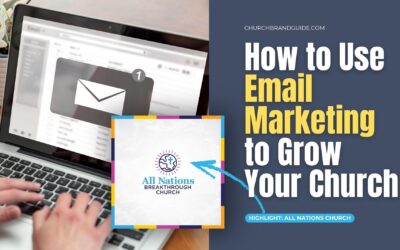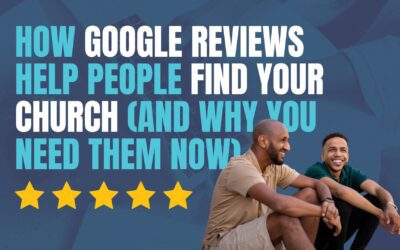The way people find and connect with churches has changed dramatically. Today, 97% of people search online before visiting a local church, making your website the first impression most potential visitors will have. But having just any website isn’t enough anymore.
A smart church website works for you 24/7, automatically connecting with visitors, gathering information, and moving people toward meaningful engagement. It’s like having your best greeter, administrative assistant, and outreach coordinator working around the clock:
Three key factors make modern church websites different from traditional ones:
- Automation that handles routine tasks like follow-up emails, event registrations, and visitor communications
- Integration with tools you already use, from social media to giving platforms
- Data collection that helps you understand and better serve your community
The most effective church websites today don’t just share information – they create connections. When someone visits your site at 2 AM wondering about service times, they can instantly get answers. When a family moves to your area and searches for “churches near me,” your website helps them find you first.
Smart church websites are becoming essential because they solve real problems. They help you reach more people, save staff time, and create better experiences for everyone who connects with your church. The best part? Most of these tools are now accessible to churches of any size.
In the following sections, we’ll explore exactly how to transform your website into a growth engine that works even while you sleep.
Churches today face a significant challenge: connecting with people in an increasingly digital world. While traditional outreach methods still matter, 97% of people now search online first when looking for a local church. Your website isn’t just another marketing tool – it’s often the first impression someone has of your church community.
A smart church website goes beyond basic information. It actively works to grow your congregation through automated systems, personalized experiences, and data-driven improvements. Unlike traditional church websites that simply display service times and directions, smart websites engage visitors, capture information, and nurture relationships automatically.
The shift in church search behavior is clear: 74% of church seekers visit at least four church websites before making a decision to attend. Your website needs to stand out and provide the information these seekers need. Smart websites make this possible by combining modern design with powerful tools that work around the clock to welcome and guide visitors.
In 2025, three key areas will determine your church’s online success: getting consistent traffic through search engines and social media, converting website visitors into in-person attendees, and building trust through authentic reviews and testimonials. Each of these elements works together to create a growth engine for your church.
Getting Traffic: Your 24/7 Digital Welcome Mat
Your church website works around the clock to welcome visitors, but it needs the right approach to attract them first. Let’s look at three key ways to bring more people to your digital front door.
Search Engine Optimization (SEO)
Monthly website updates keep your content fresh and relevant for search engines. Focus on your local community by including your city name and nearby areas in your content. Make sure your site loads quickly on mobile devices – that’s where most people will find you first.
Strategic Blog Content
Create content that answers real questions people ask about faith and church life. Write about local events, community service opportunities, and topics that matter to your area. Plan your content calendar around major church events and holidays to stay consistent.
Smart Advertising
Start small with Google Ads targeting people searching for churches in your area. Set aside $200-300 monthly to test what works. On Facebook and Instagram, focus on reaching families within a 15-mile radius of your church. Track which ads bring visitors to your services to improve your spending.
Remember to measure your results. Use Google Analytics to see which pages attract the most visitors and what content keeps them engaged. This helps you adjust your strategy and make better decisions about where to focus your efforts.
Keep your content authentic and helpful. Your website visitors are real people looking for a church home. Every piece of content should help them take the next step toward visiting your church.
Converting Visitors into Attendees
Lead magnets are your website’s secret weapon for connecting with visitors. A free downloadable prayer guide or devotional series gives people immediate value while helping you build relationships. Set up simple systems to deliver these resources automatically when someone shares their email address.
Custom event pages make a huge difference in attendance. Create dedicated landing pages for major events like Easter services or community outreach programs. Include clear details, compelling photos, and an easy registration process. Send automatic confirmation emails and reminder texts to boost show-up rates.
Follow-up matters more than most churches realize. Set up email sequences that welcome new contacts and share your church’s story over several weeks. Include information about service times, children’s programs, and ways to get involved. Track which emails people open and click to understand what interests them most.
Text messages get 98% open rates compared to 20% for emails. Use SMS to send friendly reminders about upcoming events or check in with first-time visitors. Keep messages personal and helpful rather than promotional.
Make registration simple with mobile-friendly forms that take less than 60 seconds to complete. Remove unnecessary fields and only ask for essential information. Test your forms regularly on different devices to ensure they work smoothly.
Connect your website tools to your church management system. This helps you track the journey from first website visit through event attendance and eventual membership. Use this data to improve your outreach and welcome process continuously.
Remember that every website visitor represents a real person seeking connection. Focus on serving them well through helpful content and simple next steps. When you make it easy for people to engage, they’re more likely to become part of your church family.
Building Trust Through Reviews
Online reviews shape how people choose a church today. A strong collection of positive Google reviews helps your church appear more often in local searches and builds confidence with potential visitors.
Recent studies show that 87% of people read online reviews before visiting a new business or organization. This applies to churches too – people want to hear real experiences from actual attendees.
Here’s how to build a strong review presence:
Ask at the Right Time
Request reviews when people are most excited about their experience. This could be right after:
- A powerful worship service
- A successful community event
- A meaningful volunteer experience
- A child’s positive experience in youth ministry
Make It Simple
Create a direct link to your Google review page and share it through:
- Your email newsletter
- Text message follow-ups
- Social media posts
- Printed cards at welcome desks
Respond to Every Review
Thank people who leave positive feedback. Address concerns professionally in negative reviews. Quick, thoughtful responses show you value feedback and care about your community.
Use Technology to Help
Set up automated systems to:
- Send review requests via email/text
- Track new reviews as they come in
- Alert staff when responses are needed
- Measure review growth over time
Remember to follow Google’s guidelines – never offer incentives for reviews or post fake ones. Focus on gathering authentic feedback from your real church community.
Smart Website Features That Drive Growth
Modern church websites need powerful tools that work together seamlessly. Let’s look at the essential features that will help your church grow:
Integration Capabilities
Your website should connect smoothly with the tools you already use. Connect your social media accounts to automatically share new content. Link your advertising accounts to track results in one place. Plus, integrate your communication systems to reach people through email and text messages without extra work.
Analytics and Tracking
Numbers tell the story of your website’s success. Track these key metrics:
- First-time visitor count
- Time spent on service pages
- Event registration numbers
- Download rates for resources
- Email signup conversion rates
Use a simple dashboard to see all these numbers at once. This helps you make better choices about what’s working and what needs improvement.
Automation Tools
Save time and reach more people with automated features:
- Schedule content updates for holidays and events
- Send welcome emails to new visitors automatically
- Update your calendar when new events are added
- Create follow-up sequences for first-time guests
- Generate reports on website performance
These smart tools work in the background while you focus on ministry. They ensure consistent communication and help you maintain connections with your community.
Remember: your website should make your job easier, not harder. Choose features that reduce manual work and create clear paths for visitors to connect with your church.
Taking Action
Start by examining your current church website through a visitor’s eyes. Open an incognito browser window and try to find service times, directions, and what to expect on your first visit. Note any frustrations or roadblocks you encounter.
Next, create a simple scorecard for your website. Rate these essential elements on a scale of 1-5:
- Mobile responsiveness
- Page load speed
- Clear navigation
- Updated content
- Contact information
- Call-to-action buttons
Prioritize your improvements based on these scores. Focus first on quick wins that directly impact visitor experience. This might include:
- Adding clear “Plan Your Visit” buttons
- Updating outdated information
- Fixing broken links
- Improving photo quality
- Streamlining your navigation menu
Set realistic timelines for bigger changes. Create a 90-day plan that includes:
- Month 1: Technical fixes and basic updates
- Month 2: Content improvements and lead magnet creation
- Month 3: Integration of automation tools and analytics
Consider your budget and team capacity. You might need:
- Website hosting upgrade ($10-50/month)
- Professional theme ($50-200)
- Email marketing tool ($20-100/month)
- Staff training time
Ready to start? Here’s your first step: Schedule a website review meeting with your team this week. Share this article and ask everyone to complete the incognito browser test before you meet.
Need help? Book a free website review with our team. We’ll analyze your current site and provide a custom growth roadmap for 2026.
Conclusion
A smart church website isn’t just a digital brochure – it’s your most powerful tool for connecting with your community and growing your congregation. Churches using these modern website strategies have seen remarkable results, from doubling their first-time visitor numbers to increasing event attendance by 75%.
Take First Baptist Church in Atlanta, for example. After implementing automated follow-up systems and strategic content, they welcomed 200 new families in just six months. Or consider Grace Community Church, which used their optimized website to fill their Christmas services to capacity for the first time in 10 years.
Your church can achieve similar results. The tools and strategies are available right now. Start small if needed – even basic improvements to your website can make a significant difference. The key is to begin.
Remember, your website works 24/7 to welcome people, share your message, and build meaningful connections. It’s time to transform your church website from a simple information page into a growth engine that serves your mission and community.
Ready to take the first step? Your future members are already online, searching for a church like yours. Make sure they can find you.
Get the Church Branding Checklist for Free
Unlock the power of effective branding with our meticulously crafted PDF Ebook.
In a world filled with constant noise and distractions, standing out is crucial. We've put together this comprehensive guide to show you how a well-designed visual identity can be the key to cutting through the clutter and reaching your audience.
Inside, you'll discover the secrets to creating the perfect website, a memorable logo, stunning photography, and eye-catching graphics that will not only capture attention but also inspire people to take their next steps.
Whether you're a pastor, marketer, or simply someone eager to make an impact, this E-book is your roadmap to success through the art of branding.
Don't miss out on this opportunity to transform your brand and connect with your audience on a whole new level.
More Podcast Episodes
How to Use Email Marketing to Grow Your Church and Engage Your Community
In today's digital world, churches face a unique challenge: staying connected with their congregation while reaching new members. Email marketing offers a powerful solution, with 99% of users checking their email daily and religious organizations seeing an impressive...
How Google Reviews Help People Find Your Church (And Why You Need Them Now)
In today’s digital world, Google Reviews are essential for churches looking to connect with new members. Recent studies show that 97% of consumers use online search to find local organizations, including places of worship. For churches, these reviews serve as digital...
How to Market Your Church in May: Reengage Visitors & Strengthen Your Core
May presents a perfect opportunity for churches to build on Easter's momentum and prepare for summer growth. With warmer weather and renewed spiritual interest, this month offers unique chances to connect with both visitors and long-time members. The weeks following...
Seasonal Church Marketing Strategy Leading Up to Easter
March Marketing Strategy Easter represents the biggest attendance opportunity of the year for churches. Research shows church attendance doubles on Easter Sunday compared to regular weeks, with an average increase of 102% according to LifeWay Research. Just as...
Church Logo Design Trends That Make You Stand Out
In this video, we explore the latest trends in modern church logo design that are shaping the visual identities of churches today. Discover how flat designs, bold fonts, and abstract symbolism are helping churches create simple yet powerful logos.
The Importance of a Modern Church Logo in Today’s Digital World
Watch the Podcast EpisodeA church logo is more than just a pretty picture – it's the face of your church's brand and visual identity. In today's fast-paced world, a modern church logo can appeal to both your existing members and attract new visitors. Many churches are...









